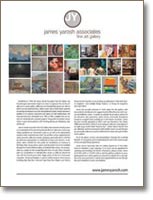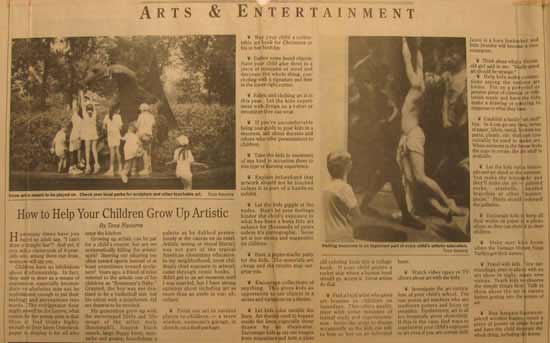 |
|
 |
WHATS NEW |
| [ BACK ] |
 |
| |
How to Help Your Children Grow Up Artistic
By Tova Navarra
December 8, 1993
How many times have you heard an adult say, “I can’t draw a straight line”? And yet, if you ask a classroom of 6-year-olds who among them can draw, everyone will say yes.
Children have no inhibitions about draftsmanship. In fact, they need to draw as a means of expression, especially because their vocabularies may not be sophisticated enough to put their feelings and perceptions into words. The refrigerator door might as well be the Louvre; what counts for the young ones is that Mom or Dad thinks highly enough of their latest Crayola-on-paper to display it for all who enter the kitchen.
Growing up artistic can be par for a child’s course, but are we systematically killing the artistic spirit? Steering our offspring too often toward sports instead of at least sometimes toward sculpture? Years ago, a friend of mine referred to the artistic one of his children as “Rosemary’s Baby.” Granted, the boy was not destined to be a basketball star, but his talent with a paintbrush did not deserve to be mocked.
My generation grew up with the stereotyped 1940s and ‘50s image of the artist: male (hmmmph!), foppish black smock, large floppy beret, mustache and goatee, brandishing a palette as he dabbed pretentiously at the canvas on an easel. Artistic seeing or visual literacy was not part of the typical American elementary education. In my neighborhood, most children’s chief exposure to artwork came through comic books. I didn’t get to an art museum until I was married, but I have strong opinions about including art as more than an aside in our, uh, culture.
- Point out art in various places to children – a store window, someone’s garage, in church, on a food package.
- Buy your child a coffee-table art books for Christmas or his or her birthday.
- Gather some found objects. Have your child glue them to a piece of masonite or wood and decorate the whole thing, concluding with a signature and date in the lower right corner.
- Fabric and clothing art is in this year. Let the kids experiment with design on a t-shirt or sweatshirt they can wear.
- If you’re uncomfortable being tour-guide to your kids in a museum, ask about docents and others who offer presentations to children.
- Take the kids to museums of any kind to accustom them to this type of learning experience.
- Explain beforehand that artwork should not be touched unless it is part of a hands-on exhibit.
- Let the kids giggle at the nudes. Don’t let your feelings hinder the child’s exposure to what has been a bona fide art subject for thousands of years unless it’s pornographic. Some art is too strong and suggestive for children.
- Have a papier-mâché party for the kids. The materials are cheap and the results may surprise you.
- Encourage collections of anything. This gives kids an opportunity to see objects in a series and variations on a theme.
- Let kids color outside the lines. Art doesn’t need to happen inside the lines, especially those drawn by an illustrator. Encourage kids to cut out images from magazines and turn a plain old coloring book into a collage book. If your child pastes a rocketship where a human head should go, accept it. Great artists do that.
- Find a local artist who gives art lessons to children on Saturdays. This offers quality time with some measure of formal study and experimentation. Invite the artist to dinner occasionally so the kids can talk to him or her on an informal basis.
- Watch video tapes or TV shows about art with the kids.
- Investigate the art curriculum of your child’s school. I’ve run across art teachers who are mediocre potters and focus on ceramics. Furthermore, art is all too frequently given short-shrift. If this is the case, find ways to supplement your child’s exposure to art even if you are certain little Jason is a born linebacker and little Jennifer will become a neurosurgeon.
- Think about what a 10-year-old girl said to me: “Really good art should be strange.”
- Help kids make connections among the various art forms. Put on a powerful or pensive piece of classical or folklorish music and have the kids make a drawing or painting in response to what they hear.
- Establish a family “art stuff” box. In it can go any item, scrap of paper, fabric, metal, broken toy parts, plastic, etc. that can conceivably be used to make art. When someone in the house feels the urge to create, the art stuff is available.
- Let the kids run a lemonade-and-art stand in the summer. You’ll make the lemonade and they’ll make the art – painted rock, seashells, beaded bracelets or other “masterpieces.” Prices should undersell the galleries.
- Encourage kids to keep all their works on paper in a photo album so they can show it to their children.
- Make sure kids know where Teenage Mutant Ninja Turtles got their names.
- Travel with kids. New surroundings, even to places with no art show in sight, mean new visions. Teach kids to observe the simple things first: Talk to them about the art in nature before getting into the nature of art.
- Buy bargain-basement priced wooden frames, insert a piece of poster or other board and have the child decorate the whole thing, including the frame.
- Allow kids to hang art, prints or posters in their rooms. If they prefer a Batman and Catwoman poster, accept that. Never discount any person’s tastes, especially a child’s.
- Art is therapy. If your child cannot express something weighing on his or her mind, ask him or her to “talk” to you with a drawing.
- Ask your kids to comment on the colors, shapes, styles and “moods” of various objects, including clothing, furniture and accessories. This sharpens their eye to aesthetic products.
- Always remember that a society without art might as well be a black hole.
|
| |
|
|
 |
|